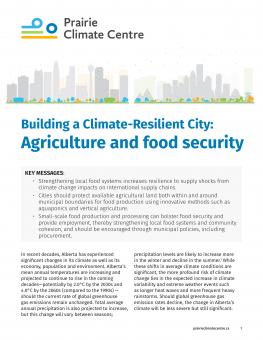
Building a Climate-Resilient City: Agriculture and food security
This policy brief focuses on measures related to agriculture and food security that cities can take to build their resilience to climate change.
This policy brief focuses on measures related to agriculture and food security that cities can take to build their resilience to climate change.
It examines ways to build resilience in urban agriculture and the food system as a contribution to urban resilience building. Its purpose is to identify elements of local food systems that can be strengthened, highlight best practices in the field and suggest interventions that local governments can use to build a more resilient food system.
Key Messages
- Strengthening local food systems increases resilience to supply shocks from climate change impacts on international supply chains.
- Cities should protect available agricultural land both within and around municipal boundaries for food production using innovative methods such as aquaponics and vertical agriculture.
- Small-scale food production and processing can bolster food security and provide employment, thereby strengthening local food systems and community cohesion, and should be encouraged through municipal policies, including procurement.
The Building a Climate-Resilient City series was prepared for the City of Edmonton and the City of Calgary by the International Institute for Sustainable Development and the University of Winnipeg. This series looks makes recommendations for steps that cities can take as part of their municipal adaptation planning to build their resilience to climate change. It explores three key principles of resilience building: robustness (strong design), redundancy (building extra capacity into systems to act as fail-safe networks) and resourcefulness (citizen empowerment).
Participating experts
You might also be interested in
Building a Climate-Resilient City: Transportation infrastructure
This policy brief examines ways of building resilient urban transportation infrastructure to reduce exposure to natural hazards, decrease potential risks by implementing mitigation measures and enhance adaptive capacity in a changing climate.
Building a Climate-Resilient City: Economics and finance
This policy brief focuses on economic and financial measures to build cities' resilience to climate change.
Building a Climate-Resilient City: Urban ecosystems
This policy brief focuses on measures related to urban ecosystems that cities can take to build their resilience to climate change.
Building a Climate-Resilient City: Transformational adaptation
This policy brief focuses on how cities can build resilience to climate change through transformational adaptation.